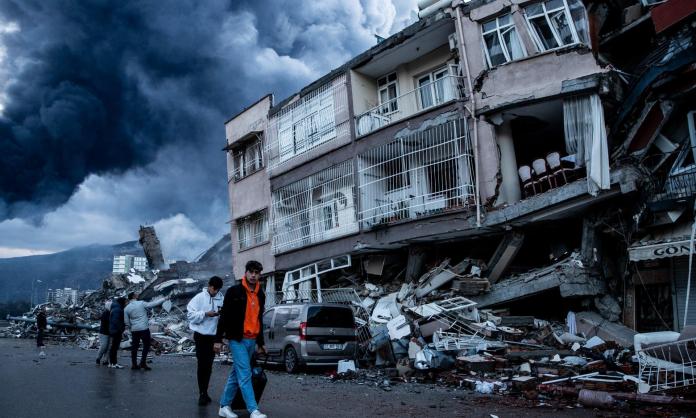“Just give us a tent!” implored Fatma, speaking to a journalist from Turkish news outlet Diken, four days after the devastating earthquakes of 6 February. She could manage thirst and hunger for a few days but the winter is too punishing to sleep outside. Fatma’s cry for help was echoed across the region as rescue efforts slowed due to the harsh winter conditions, lack of supplies, crumbling infrastructure, internal political divisions and in the case of Syria, long-term isolation due to civil war.
The first, massive 7.8 magnitude earthquake struck early in the morning. Its epicentre was in Gaziantep, the largest city in southeast Türkiye. Nine hours later—as people were trying to rescue their loved ones and calling for help—a second, 7.6 magnitude earthquake hit neighbouring Kahramanmaraş. Ten Turkish cities in total were affected, along with parts of northern Syria, covering a massive area which makes rescue efforts difficult and resource intensive.
At the time of writing, the death toll topped 23,700. Over 70,000 were injured in Türkiye alone and over 6,000 buildings have collapsed. The numbers are expected to continue rising. It will take days, most likely weeks, for the true scale of the tragedy to be revealed.
The area most impacted by the earthquake is home to many members of Türkiye’s Kurdish community, as well as, in recent years, a large population of Syrian refugees. This disaster comes on top of decades of underdevelopment—a conscious policy of the Turkish state stemming from its desire to stamp-out Kurdish national aspirations—and, in the case of Syrians, very recent, traumatic experience of war, dispossession and displacement.
During his visit to the region in the aftermath of the earthquake Turkish president Recep Tayyip Erdoğan told the people that “these things are in fate’s plan”. The truth is far from it.
The author of this article was in Istanbul, less than an hour’s drive away, when on 17 August 1999 an earthquake in İzmit-Düzce claimed over 17,000 lives. In response to that disaster—after years of debate—a new building code was introduced, bringing Türkiye up to international standards. Then in 2012 the ruling Justice and Development Party (AKP), led by Erdoğan, introduced the notorious “Urban Transformation Law”, which allowed the state to take over and rebuild buildings government bureaucrats deemed unsafe.
All this was supposed, in theory, to reduce the risk of damage from earthquakes as well as improving urban amenity more generally. From the start, however, the system has been undermined by corruption and crony capitalism.
This has been supercharged under the AKP, which has strong ties to property developers and makes liberal use of so-called zoning and building code amnesties—a regular feature of patronage politics in Türkiye. Millions of buildings built without permission or in unzoned areas have been certified legal in exchange for political support and votes. For the property developers and the government, it’s a “win-win” arrangement. The government maintains the support of a powerful sector of capital, while a number of recently founded property developers have quickly grown into major national, and international players.
We know however that where private profit booms, ordinary people are likely to suffer. That is certainly the case in Türkiye today. The AKP’s policies are far from having been a “win” for people living in cities, like Istanbul, that have been “transformed” to the almost total exclusion of green-space or community gathering places, or for people living in buildings constructed by developers whose political patronage has been rewarded with “amnesty” from relevant standards.
In the aftermath of the earthquake, Erdoğan has lashed out at critics. With an election coming up this year, he wants to avoid the impression of weakness or incompetence. In a furious address to the nation, he said that he is “watching closely those who aim to divide us with lies and distortions while the government and nation hand in hand try to address this historic disaster”.
Dissenting voices on social media, such as political scientist Özgün Emre Koç, have been detained by police for criticising the government’s response. The government has also sought to curb the volunteer-driven rescue effort seen in the first days after the earthquake, because it undermines the narrative of an all-powerful state. Volunteers now need permission from the Turkish disaster management agency before helping with rescue operations.
A notable difference between the 1999 earthquake and today is how the media has covered the disaster. In 1999 the major Turkish newspaper Hürriyet famously ran with the headline “MURDERERS”—referring to property developers and to state officials who granted titles to properties not adhering to building codes. Today, newspapers like Sabah have given prominence to quotes from Erdoğan such as “our nation needn’t worry”. After years of state attacks and repression, media ownership has consolidated into a few safe, pro-AKP capitalist hands.
Earthquakes may well be “fated” to strike in countries like Türkiye that sit atop the boundaries of shifting tectonic plates. But the extreme level of death and destruction that occurred in this case (and has occurred in so many other “natural” disasters over the years) is a direct result of the profit-driven logic of capitalism.
Turkish and Syrian working people must come together to put an end to the cycle of sacrifice and loss and make the developers and politicians answer for the many unnecessary deaths. The hope demonstrated by the community rescue efforts and the anger ripping through society are both needed in the battle against the kind of society that lets people live in unsafe buildings or die trapped under them.










